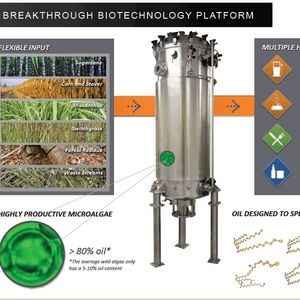Renewable oil plant begins commercial production in Brazil

Source: Solazyme Inc.
June 3, 2014
BY Ron Kotrba
Solazyme Inc. announced in late May that its joint venture with Bunge Global Innovation LLC has begun commercial production at the Solazyme Bunge Renewable Oils plant in Brazil, constructed adjacent to Bunge’s Moema sugarcane mill in São Paulo state. The facility, based on a sugar-to-oils platform, is producing renewable oil and Encapso, a trademarked encapsulated lubricant. Solazyme says production is continuing and is expected to reach nameplate capacity within the next 12 to 18 months.
“With production underway at the Solazyme Bunge Renewable Oils plant, Solazyme is manufacturing products at three large-scale facilities, including our 2,000 metric ton per year (MT/year) integrated facility in Peoria, Ill., the 20,000 MT/year Iowa facilities in Clinton/Galva and the 100,000 MT/year facility in Brazil,” said Jonathan Wolfson, CEO of Solazyme. “Continued progress at the recently completed adjoining co-gen facility has resulted in more reliable power and steam, enabling startup of commercial operations and production of our first commercially saleable product. We are truly excited to have begun manufacturing operations at our joint venture’s flagship facility in Brazil.”
Advertisement
“The start of production at the Solazyme Bunge Renewable Oils plant is an important milestone for this joint venture,” said Ben Pearcy, the managing director of sugar and bioenergy at Bunge Ltd. “We’re proud of the work we have done with our partner Solazyme in bringing the world's first built-for-purpose renewable oil plant on line. We remain committed to the success of the joint venture and see significant market opportunities that we can address together.”
Advertisement
Related Stories
The USDA maintained its outlook for 2025-’26 soybean oil use in biofuel production in its latest World Agricultural Supply and Demand Estimates report, released Aug. 12. The forecast for soybean oil prices was also unchanged.
U.S. soybean production for 2025 is forecast at 4.29 billion bushels, down 2% when compared to last year, according to the USDA National Agricultural Statistics Service’s latest monthly Crop Production report, released Aug. 12.
California’s new specified source feedstock attestation requirement: A critical new compliance step for renewable fuel producers
As of July 2025, California’s SCFS requires renewable fuel producers using specified source feedstocks to secure attestation letters reaching back to the point of origin. This marks a significant shift in compliance expectations.
At the University of Missouri, plant biochemist Jay Thelen is using arabidopsis as a powerful model to explore ways to boost oil production — an important step toward creating more sustainable, plant-based energy sources.
Iowa farmers have a new market opportunity for their 2025 soybean crop. Landus is expanding its Clean Fuel Regulation initiative, made possible by recent policy changes expected to increase Canada's demand for liquid biofuel.
Upcoming Events










